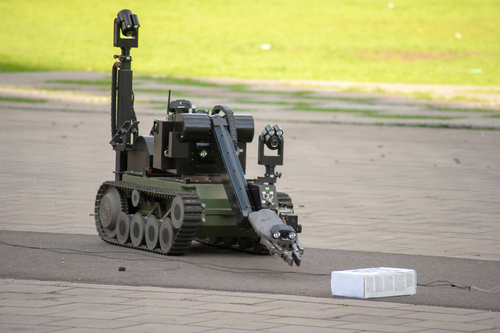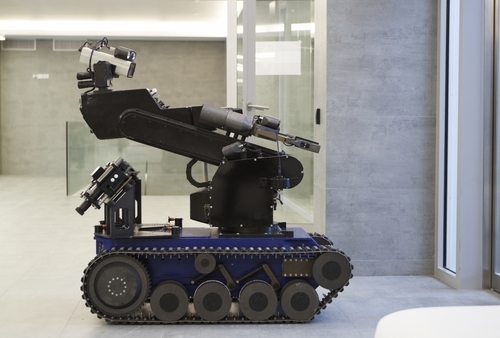R.E. Kearney's Blog, page 8
October 27, 2022
Arming Robots
It’s another step closer to the story line from James Cameron’s Terminator movies, but one that’s being seriously considered by police in Oakland. They believe that the society we now live in justifies taking a bold step forward in weaponizing robots.

Oakland Police have added a “Percussion Actuated Nonelectric Disruptor (PAN Disruptor) as a top priority for 2022. A PAN is a laser-aimed shotgun-like attachment for wheeled robots which until now have previously been used in war zones or for sending in to diffuse or detonate a bomb. These robots are not autonomous. Similar robots have been weaponized by the US military with machine guns, although the military say they are for shooting suspected explosive devices. The gun can be loaded with blanks as well as live rounds making them potentially lethal.
“One can imagine applications of this particular tool that may seem reasonable,” said Liz O’Sullivan, CEO of the AI bias-auditing startup Parity and a member of the International Committee for Robot Arms Control, “but with a very few modifications, or even just different kinds of ammunition, these tools can easily be weaponized against democratic dissent.”
Oakland Police Department had originally promised to only use the killing machines when deemed necessary, during “certain catastrophic, high-risk, high-threat, or mass casualty events.” However, they would not rule out the potential to use live ammunition “if they need it for some situation later on.”
A 2021 subcommittee meeting looked at the potential for arming robots, and agreed the robots could not be used to kill humans, but would allowed them to be armed with pepper spray.

“We will not be arming robots with lethal rounds anytime soon,” Lieutenant Omar Daza-Quiroz told the Intercept. “If and when that time comes each event will be assessed prior to such deployment.”
Incredibly this isn’t the only police department that is considering upgrading their staff. In 2016 Dallas Police Department used a wheeled robot to take down an alleged cop-killing sniper. The robot placed a bomb near the suspect who was cornered in a parking garage. Allegedly the suspect said he’d placed explosives around the city. “After a prolonged shootout we saw no other option but to use our bomb robot and place a device on it for it to detonate where the suspect was. Other options would have exposed our officers to grave danger,” explained Dallas Police Chief David O. Brown.
Also, in 2014 Albuquerque police deployed a bomb robot to release tear gas on an armed suspect.
In a similar way, North Dakota has legalized the use of police drones equipped with tasers and pepper spray. It seems like Oakland Police is merely following a trend to weaponize robots, which hopefully will continue to remain in the control of a human operator.
Reassured yet? Whilst the use of a robot in dangerous situations will undoubtedly save the lives of police and emergency responders, arming a robot could be a step too far.
October 13, 2022
Living Longer
With the world on the brink of a potential nuclear Armageddon, sea levels rising, and micro plastics poisoning our oceans as well as our bodies, perhaps the last thing on your mind right now would be how to extend the length of time you endure on planet Earth. However, scientists have discovered a way to extend the life expectancy of mice by ten percent – which some people are considering a potential answer to extending human life.

Scientists from Harvard Medical School, administered a drug called Rapamycin into 130 genetically different mice during the first 45 days of life through their mother’s milk. 40 other mice also took part in the study, acting as a control group, and were not provided with Rapamycin. All of the 170 mice were kept in exact conditions until they reached a natural end to their life.
Those mice who had received Rapamycin during the early days of their lives lived significantly longer than those who hadn’t. Not only did they live longer, but scientists also believed that the aging process actually slowed down in the male mice, taking them longer to progress through the normal life cycles expected in rodents. In addition, the male mice were also faster, stronger and healthier than normal.
But why would this be? Once the study had finished the scientists found that there were cellular changes that made the mice live longer. They appeared to have younger liver transcriptomes (genetic codes) giving additional fuel to the hypothesis than the secret to anti-ageing begins with our early development.

“Overall, the results demonstrate that short-term Rapamycin treatment during development is a novel longevity intervention that acts by slowing down development and aging,” the study explains, “suggesting that aging may be targeted already early in life.”
Researchers have also tested the drug on a crustacean with similar results.
Rapamycin is an immunosuppressive drug used in the treatment of cancers, as well as being used to prevent rejection during organ transplants, but has gained the attention of medical scientists as a potential anti-ageing drug.
This study could be merely the beginning to a whole new scientific breakthrough in extending life on earth. Although it appears to work in mice, the administration of Rapamycin for humans could be a long way away, with health implications for a human remaining unclear.
September 29, 2022
Cancer Killing Virus
A genetically modified form of the Herpes virus has been successfully used to attack tumors in cancer patients. Scientists at The Institute of Cancer Research and The Royal Marsden NHS Foundation Trust created this unusual solution from the virus that causes the cold sore!
Even though this is in its early stages of development and requires many more follow up trials and studies, the initial results seem to be positive.

Krzysztof Wojkowski from West London was diagnosed with cancer of the salivary gland in 2017. “I was told there were no options left for me and I was receiving end-of-life care,” he explains. “It was devastating, so it was incredible to be given the chance to join the trial.”
The trial works by injecting the virus (RP2) directly into the tumor. The virus invades the cancer cells, causing them to burst and activating the patient’s immune system to help.
“I had injections every two weeks for five weeks which completely eradicated my cancer. I’ve been cancer-free for two years now.”
There were 40 participants in the trial – nine had the RP2 injections, while the rest had a combined treatment of RP2 and another drug called nivolamb. The tumors of three of the patients who had the RP2 injections shrunk after treatment.

Project lead researcher Kevin Harrington said, “It is rare to see such good response rates in early stage clinical trials, as their primary aim is to test treatment safety, and they involve patients with very advanced cancers for whom current treatments have stopped working.”
Using viruses to attack cancers isn’t actually a new treatment. In 2021 researchers from the University of Zurich modified a respiratory virus called adenovirus, to enter tumor cells and deliver genes that tricked tumor cells into producing therapeutic antibodies.
“We trick the tumor into eliminating itself through the production of anti-cancer agents by its own cells,” said Sheena Smith at University of Zurich.
Whilst traditional therapies such as Chemotherapy and radiotherapy attack the normal healthy cells in a patient’s body, this doesn’t happen when using viral based therapies. Interestingly the recent COVID vaccines utilize adenoviruses.
September 15, 2022
Alien Ocean Wreckage
Avi Loeb, a professor at the Harvard-Smithsonian Center for Astrophysics, is a firm believer that alien life exists, despite his peers sometimes rolling their eyes with disbelief. In 2021 Loeb suggested that it was possible that an alien civilization had seeded the Earth with sensors to monitor its potential for habitation. This suggestion was linked to something called “Oumuamua” – an interstellar object that entered our solar system in 2017. Oumuamua was discovered by Robert Weryk at the Haleakala Observatory in Hawaii when he observed it passing close to the sun. He estimated it to be about 100 to 1,000 metres long, red in color, and exhibiting non gravitational acceleration. It was thought to be a remnant of a disintegrated rogue comet. However Loeb was convinced that Oumuamua was something much, much more, and that it was actually monitoring Earth for signals from probes left on the planet in the past.

However, his latest suggestion concerns a meteor which struck the Earth in 2014. Small meteors often enter our atmosphere but disintegrate harmlessly as they travel into our atmosphere. Loeb’s meteor was about two feet long but broke into fragments before entering the South Pacific Ocean.
“It moved very fast, roughly 40 kilometers per second when it exploded in the lower atmosphere,” Loeb told the Associated Press. Loeb believes that the meteor may be extraterrestrial in origin, based on his speculation that the strength of the meteor was twice as tough as that of an iron meteorite. In 2019 Loeb’s findings were rejected, but more recently a memo from the US Space Command seems to add some weight to Loeb’s theory, confirming the meteor originated from a different solar system.
Loeb has now launched a privately funded expedition to search the bottom of the South Pacific Ocean with a magnet sled, to retrieve samples of the meteor from a 40 square mile area.

“The ideal scenario is that in addition to tiny fragments, we would find a piece of an advanced technological device, like the hundredth version of the iPhone,” Loeb told Salon. “I would love to press a button on such an object.”
The scientific community is not convinced. Science writer Ethan Siegel said: “The alien technology hypothesis is so far-fetched that there is no scientific reason to consider this as anything other than someone with no evidence crying wolf when there is no wolf that we have ever seen before.”
Professor Avi Loeb is currently looking for investors for his expedition, called The Galileo Project, and is hoping to raise 1.5 million dollars.
August 25, 2022
Speaking to the Dead
Artificial Intelligence has come a long way in the last decade, but this latest advancement might be one of the most unusual applications for it – allowing the dead to speak to you!
In what was a surprise to the mourners at her funeral, Marina Smith was able to address them via a holographic conversational video experience, which was created by a startup company called StoryFile. Interestingly StoryFile was founded by Marina Smith’s son, Stephen Smith, based in LA. StoryFile was originally created to preserve the memories, recollections and stories of the Holocaust survivors. But, with Marina, they took 20 cameras and filmed her answering about 250 questions, allowing them to virtually recreate her in their software to make her appearance at her own funeral appear as natural as possible.

With so much visual and vocal data, Stephen Smith was able to converse with his mother at the funeral, as well as allowing other attendants to ask questions.
“The extraordinary thing was that she answered their questions with new details and honesty,” Stephen explained. “People feel emboldened when recording their data. Mourners might get a freer, truer version of their lost loved one.”
However, this wasn’t the first time StoryFile had used their technology to recreate a dead person at their own funeral. Earlier this year former Screen Actors Guild president Ed Asner answered questions from the mourners at his own funeral.
“Nothing could prepare me for what I was going to witness when I saw it,” said Matt Asner, Ed’s son. “Other attendees were ‘a little creeped out’ because it was like having him in the room.”

Currently, in Silicon Valley, there seems to be a bit of a trend to technology which allows users to speak to the dead. Amazon added a new feature to their Alexa speaker, allowing the voice of a dead relative to read a bedtime story to a child. Amazon made this possible, not by taking hours of recording in a studio, but by sampling less than a minute of speech. “We are unquestionably living in the golden era of AI, where our dreams and science fictions are becoming a reality,” said Rohit Prasad, head scientist for Alexa.
Whilst the application of mimicking a dead person’s voice might be comforting to some, it’s also seen by many as a step too far and an obscure use of Artificial Intelligence. It could also open up the possibilities for criminals using a person’s voice, dead or alive, for nefarious purposes.
August 11, 2022
Brain Implants
For many years medical teams have tried to come up with a permanent prevention or cure for paralysis, and it appears that scientists and medical researchers have made significant breakthroughs in the form of a brain implant.
Fortunately, brain implants have worked for many patients who were sure they were going to live the rest of their lives without being able to move their arms and legs due to severe spinal cord or head injuries. By using a brain-computer interface the lost connection between the brain and other organs was restored, allowing the patient to live their life like a normal healthy individual. It is a huge step forward in medicine.

There is an argument about whether the much sought-after treatment will be available for patients from all social classes? More importantly, will it be easily available in third-world countries where the rate of disease leading to paralysis is significantly high?
The procedure costs somewhere between $70,000 and $100,000 making it too expensive for most people with or without health insurance.
It will be quite a few decades until the procedure is available, but the procedure does not seem to be widely available due to the complex nature and cost. Even more common performed treatments like liver and kidney transplants are not easily available in many parts of the world.
Despite this, it is a remarkable discovery by scientists. Hopefully, with more researches and investment, more accessible options might be available for the benefit of everyone.

In a separate study, Scientists from Stanford successfully implanted a device into a man’s brain that allowed his paralyzed hands to type words with nothing more than the power of thought. Known as a Brain-Computer Interface (BCI), it enables the user to restore basic motor skills including talking and moving, by decoding the neural activity in the motor cortex. But this could only be the start of some incredible things to come, including curing mental health issues.
Theodore Berger, a neuroscientist in Southern California, has been working on a memory chip that mimics the function of the Hippocampus – the part of the brain responsible for memories. Using the chip Berger has successfully managed to restore long term memory in rats. Trials in humans are in the very early stages, but with millions of people suffering from neurodegenerative complications from Alzheimers, Strokes or brain injuries, it seems that there are many applications for Berger’s technology should it be successful in trial.
July 21, 2022
Plastic Eating Superworms
The Garbage crisis has been an alarming threat to our environment with warnings that the escalating rate of global waste will be 70 percent higher than present levels by 2050 if preventive actions aren’t initiated.
Our world potentially produces 400 million tons of plastic annually. Moreover, the plastics are stuffing the landfills and adversely impacting our natural environment. Plastic waste has become prevalent to such an extent that its particles are encountered in our air, food, and blood. Furthermore, plastic particles have significantly contaminated several habitats especially, the ocean and wildlife.

According to scientific research, plastic may take millennia to biodegrade. However, recently scientists from different regions have been trying to find a natural method to eradicate or at least minimize the potential crisis. This collaborative research involved locating micro-organisms that can digest plastic, equivalent to the process of biodegradation. They have since discovered “superworms” that can survive and grow by consuming polystyrene, familiarly known as styrofoam. This study was published in the journal Microbial Genomics.
The named “Superworm” is a colloquial identity for larval stages of the darkling beetle. In addition, the researchers identified natural enzymes that can be utilized to recycle styrofoam.
In an email, Chris Rinke, a senior lecturer at the Australian Center for Ecogenomics (ACE) at the University of Queensland and the study’s principal author, stated, “Insect larvae have a strong track record of destroying and digesting plastics. Other scientists have mentioned that waxworms and ordinary mealworms can consume plastic, so we reasoned that if these relatively small larvae can do it, the huge superworms (up to 5.5 cm long) could be even more productive.”
He further said, “It came out that superworms had a strong hunger for polystyrene. When we started our studies, we didn’t know if superworms could thrive on plastic, but we had great expectations.”
Rinke and his colleagues arrived at this result by dividing 171 superworms into three categories, each with a distinct diet: one group ate primarily polystyrene, another ate bran, and the third were not fed. According to the study, incidents of cannibalism amongst fasting superworms “lead to our modified experimental setup keeping the hungry comparison group creatures in seclusion, whilst individuals in the other two groups were kept together throughout the feeding trial.”

Superworms are tough little organisms, with over 95% of each group surviving their three-week diets. The bran-fed worms acquired the most weight, but the polystyrene-fed larvae were also somewhat heavier and more active than the starving worms, indicating that they were able to obtain nutrients from the plastic waste—albeit at a cost to their health.
“We now have a catalog of all the bacterial enzymes transcribed in the superworm stomach, and we aim to look into the enzymes that degrade polystyrene,” Rinke added. “Over the next few years, we’ll profile them in more depth to identify the most efficient enzymes, which may subsequently be further enhanced via enzyme engineering.”
To conclude, Rinkie anticipates finding economical and practical methods to recycle plastic. This contribution can tremendously assist in reducing the global waste crisis.
July 14, 2022
Alien Signals
“Two possibilities exist: either we are alone in the universe or we are not, both are frightening.”- Arthur C. Clarke
Astrophysicists have been meticulously working to detect interplanetary lifeforms for decades. The prospect of extraterrestrial presence has always piqued the curiosity of scientists and as a result, they are tirelessly engaged in their attempt to locate evidence. However, the certainty of ‘life beyond earth’ might have been proved via a recently detected strong radio signal.

To achieve success in decade-long research for an alien broadcast, numerous technologies have been introduced to catch a signal from a distant world. One of these advanced inventions includes China’s Five-hundred-meter Aperture Spherical radio Telescope (FAST), nicknamed ‘Sky Eye’, which is regarded as the largest radio telescope in the world. It came into existence in 2019 with an aim to deep scan space for extraterrestrial life by receiving radio signals.
On June 15th, an unusual narrow-band radio signal was picked up by the Sky Eye. The announcement sparked excitement however, scientists exercised caution stating that this finding was preliminary and yet to be thoroughly analyzed.
As mentioned in the original paper, the signal was located from the direction of an exoplanet within the habitable zone of Kepler-438, acknowledged as a doppelganger of earth. However, the habitability of Kepler-438 has not been confirmed yet. The suspicious signal was discovered during the targeted alien-hunting mission. Furthermore, the paper stated that the signal was monitored for 20 minutes, demonstrating that it was approaching from an orbital celestial body, most likely the earth-like exoplanet.
“These are multiple narrow-band electromagnetic signals distinct from the past,” said Zhang Tongjie, chief scientist at Beijing Normal University’s China Extraterrestrial Civilization Research Group. “The team is currently conducting more research,” he stated. “The possibility that the unusual signal is radio interference is also very strong, and it has to be confirmed and ruled out further. This might be a lengthy process.”
Nevertheless, this isn’t the first time that scientists have been baffled by a mysterious signal. In the year 1977 a search executed by the Big Ear telescope at Ohio State University discovered a mind-bogglingly brief electromagnetic burst that blazed at a frequency that scientists believe could be utilized by alien civilizations. However, the proceeding searches revealed that the signal could have been received from a sun-like star located in the constellation Sagittarius.

Dan Werthimer, a researcher at the Beijing Normal University SETI poured cold water on the signal possibilities and remarked “All of the signals received by SETI researchers thus far have been generated by our own civilization, not by another civilization. Observing SETI from the surface of our planet is becoming increasingly difficult. As more transmitters and satellites are created, radio pollution is increasing. Some radio bands are no longer available for SETI.”
In addition, Zhang Tongjie spoke to the Chinese government-affiliated publication Science and Technology Daily. “It may take some time to verify one way or the other, but even if the signal turns out to be interference, it will provide vital information for our future SETI investigations.”
June 30, 2022
Invisible Space Walls
Space is mysterious and surprising dimensions are unveiled every day, leaving scientists and space enthusiasts perplexed. This time, an astonishing proposal was revealed that could result in a revolution in the laws of astrophysics.
Scientists believe that there may be invisible walls in space, but not like the walls in our homes. Instead, barriers are created by a fifth force mediated by a new hypothetical particle referred to as a Symmetron. Furthermore, this revelation could assist scientists in understanding traditional and challenging aspects of the world of space.

This new aspect of physics could also explain the complicated theories to the conventional model of cosmology, termed Lambda Cold Dark Matter, and could help to reveal the understanding our universe in a better way. Lambda Cold Dark Matter proposes that small galaxies circulate in disorganized orbits of giant galaxies. However, the recent study altered the previous notion, proposing that the smaller galaxies orbit the giant galaxies in a thin flat disc-like shape, similar to those seen in the rings of Saturn, due to the intense gravity of the giant galaxies.
Furthermore, scientists have discovered several reasonable answers for a problem between theory and reality known as the “satellite disc problem.” According to a new study, a duo of researchers from the University of Nottingham, has addressed what they believe is “the first potential ‘new physics’ interpretation for the studied planes of galaxies that do not do away with dark matter,” referring to the unrecognized particle that comprises the majority of the mass in the universe.

Aneesh Naik, a research companion at the University of Nottingham who spearheaded the work, said the innovative answer came through conversations with particle physics colleagues, including co-author and University of Nottingham physicist Clare Burrage’s research.
“I did my Ph.D. in astronomy, and my thesis was about galactic dynamics and how one might utilize galactic dynamics to address certain fundamental physics problems,” Naik said. “By the time I finished my Ph.D., I was thinking a lot about these small-scale obstacles to Cold Dark Matter.”
“Since we have dark matter and dark energy, we know we need new particles, and we believe we will need to add new particles to our standard model to account for these things.” Anish Naik explained. “It is the setting in which ideas such as symmetry theory are studied.” He went on to say that it is a new candidate particle for dark energy and dark matter. As a result, these particles create invisible barriers. Smaller galaxies can then form discs around much bigger host galaxies due to these barriers.
June 16, 2022
Restoring Sight
Scientists have been immersed in the journey of discovering great mysteries for decades. To comprehend the complexities of this earth to human life, we have witnessed exciting theories and claims over the years. However, this time, it is even more surprising as the collaborative efforts of these remarkable scientists have resulted in a fantastic discovery – reviving the twinkle in a dead human eye!

In medical science, the life space of human cells effects the process of organ transplants, for instance, kidneys remain usable 24 to 36 hours after the donor’s demise if preserved in the appropriate surroundings. However, this is not the case for human eye cells, as the nervous system stops working immediately after a human dies due to deprivation of oxygen. Nevertheless, earlier last week, an article was published in the New York Post spelling out the successful revival of photosensitive neurons, pioneering a revolution into the possibilities for brain and eye disorders, including blindness.
This outcome gives hope to people with eye disorders. “Just being able to take these donor’s eyes and learn how the retina works, and what is going wrong in these illnesses is a significant deal,” said Fatima Abbas, lead author of the new study at the University of Utah.

Regrettably, light-sensing cells, termed ‘photoreceptors,’ do not communicate with neighboring cells due to oxygen deprivation after death. Therefore, a particular transport unit was designed to solve this problem that included artificial blood, oxygen, and essential nutrients. This approach found that they could make the retinal cells communicate in the same way they do in living bodies.
“Past studies have restored very little electrical activity in organ donor eyes, but never to the amount we have now proven,” said Frans Vinberg, a Moran Eye Centre scientist who also participated in the study.
This breakthrough might also contribute to advances in optogenetics, allowing some patients with eye illnesses to regain their eyesight. The University of Utah research has been published in the journal eLife.



